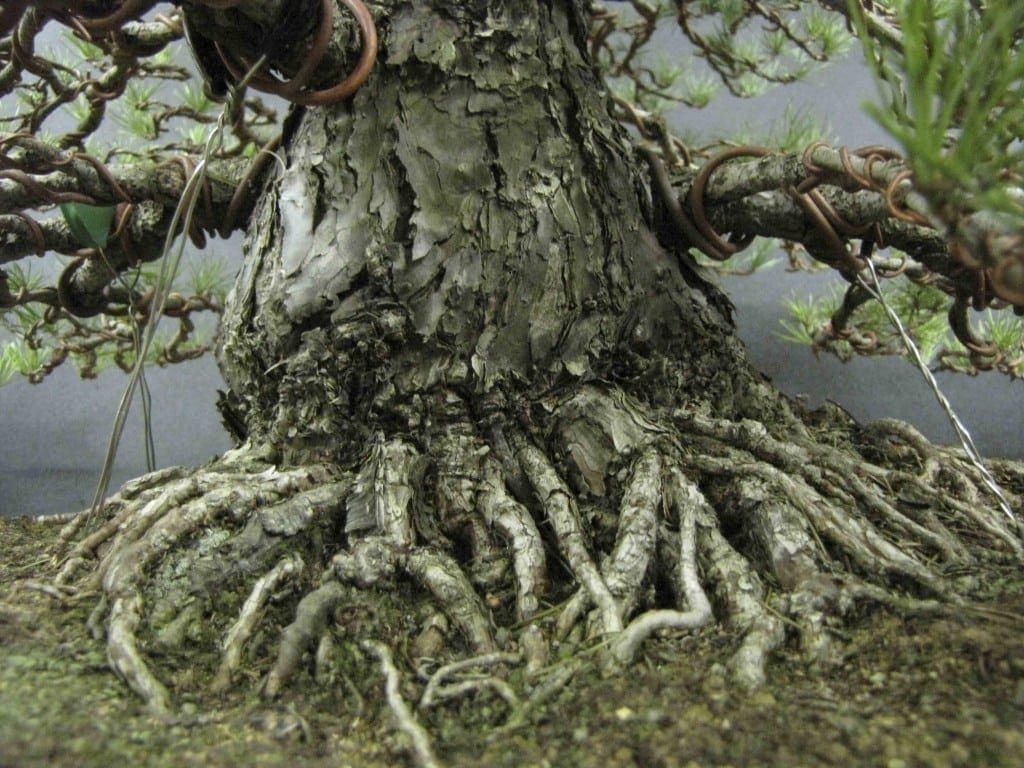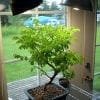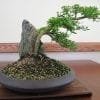Once the root structure and nebari are adequately developed, focus can shift to creating a powerful trunk. The trunk should be characteristic of its full-sized counterpart, keeping with the goal of keisho-sodai. Several qualities are essential to good trunk formation, and careful crafting will aid in forming the ideal trunk. The two elements of trunk development that are most important to consider are the trunk’s kokejunand tachiagari.
Qualities Of A Good Trunk
The bonsai’s kokejun refers to its taper. The ideal taper for a bonsai is thickened at the bottom with an even tapering as the trunk ascends. Your bonsai will need assistance in achieving this form.
The miniaturization of the tree requires an acceleration of the trunk thickening and tapering. This can be done, though, by manipulating the bonsai’s tachiagari.
The tachiagari is the plant’s initial rise and growth. Selective pruning will encourage the trunk’s proper growth and kokejun. The tachiagari period is also when the tree will grow to its mature height.
Other qualities to consider include the curves of the trunk and refinements of the form. There are some basic tree forms that have characteristic trunks. Plan ahead to the final form your tree will take. Think about future branch location, foliage distribution and leaf reduction as the trunk matures and branches sprout.
Basic Bonsai Forms
The four basic bonsai forms are chokkan, moyohgi, shakan and bunjingi.
Chokkan
Chokkan is the traditional upright form. It some ways it could be considered the most aesthetically natural form, since it is most like how a tree traditionally is seen in nature. Despite the apparently organic form, though, it still requires careful cultivation to properly develop.
Moyohgi
Moyohgi is similar to chokkan but more informal. It remains upright and similar to a full-sized tree, but it is less symmetrical. The trunk may be slightly tilted, but it remains straight and preserves the basic vertical form.
Shakan
Shakan is a slanting form. In this form, a prominent nebari grows on one side with the bulk of the limb and leaf development on the opposite side. Because of the lopsided nebari development, special planning for this form needs to be made while still actively cultivating the root development.
Bunjingi
The final form is bunjingi. It is known as the literati form. It is based on a definite line formed by the tree. The trunk, limbs, and foliage are all crafted to follow and emphasize that line. It can be a subtle difference between this form and the others, but the most notable indicator of the bunjingi form is the prominence of the trunk and the line it creates.
Shaping The Trunk
Before shaping can begin, the final form must be decided. Once chosen, the tree’s kokejun can be crafted. There are three different approaches to developing the kokejun; tachiagari cultivation repeated; pruning; and growing the trunk via selective trunk pruning. This final method is called tate-kae.
Tachiagari Cultivation For Kokejun Growth
Tachiagari development is accelerated by the growth of new limbs from the trunk. The extra branches encourage growth because they force more water and nutrients through the roots and trunk to keep them alive and growing.
Removing the branches also removes the extra nutrient flow through the trunk.
So, keeping the limbs on the tree makes the trunk grow and thicken to accommodate the extra nutrient flow.
When using this approach, be sure to always have adequate sunshine, water and fertilizer to encourage and maintain the tree’s growth.
Repeated Pruning For Kokejun Growth
With the tachiagari method, limb growth is encouraged to develop kokejun. This method expands on that by also encouraging budding on the stump. This method works for plants such as Chinese elms. The buds are repeatedly pruned and regrown to encourage trunk growth.
Pruning occurs in early summer and late autumn.
The trunk needs to be shaped with wire as it grows and thickens into its mature form. The trunk can be manipulated into its form two months after the early summer budding. This is a multi-year process, taking up to three years.
Tate-Kae For Kokejun Growth
In tate-kae, kokejun is developed by selectively pruning the trunk so as to encourage the growth of a limb. This limb will thicken and become part of the trunk. To do this, prune the trunk just above the desired branch. This can be done repeatedly to cultivate the desired trunk and ideal kokejun.
Because plants tend to grow upward and vertically, the trunk will right itself as it grows and form a prominent, strong trunk.


